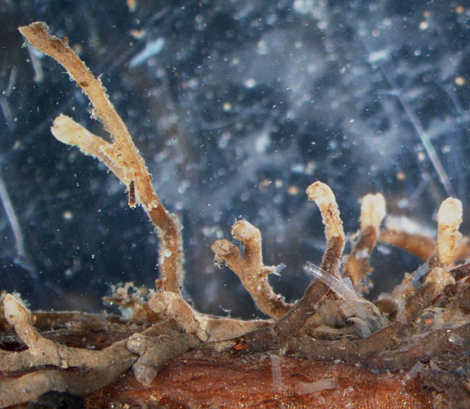
© B. OKAMURA
23 |
Text by Beth Okamura |
|---|---|

© B. OKAMURA

© B. OKAMURA
Sessile colonial invertebrates commonly found in summer, attached to hard surfaces that offer protection from sedimentation, excessive water flow and sunlight. Colonies comprise numerous, tiny (up to 1mm in length), interconnected, modular units called zooids. New zooids are created by budding and remain physiologically connected, eventually forming spreading colonies (1) of hundreds of zooids. Each zooid has a crown of tentacles (the ‘lophophore’) used for suspension feeding. Lophophores retract when the colony is disturbed, thus the beauty of these tiny animals (1a) is only apparent when placed in pond water, allowing the lophophores to evert. They are then best viewed with a stereomicroscope, which also reveals many other tiny organisms associated with the colony microhabitat. South African freshwater bryozoan diversity is poorly known.

© B. OKAMURA

© B. OKAMURA
A small group, with some 74 species described worldwide. Found in habitats ranging from running waters to ponds and lakes; tolerant of a wide range of nutrient conditions. All species produce tiny (<1mm in diameter) seed-like reproductive bodies called statoblasts (2) that typically undergo winter dormancy and achieve dispersal. Some statoblasts remain attached to surfaces; others are released as buoyant ‘floatoblasts’. Because colony morphology is highly variable, identification typically requires examining fine statoblast (2a) details, using scanning electron microscopy under high magnifications.
3 Plumatella moss animals
Plumatella species


© B. OKAMURA

© B. OKAMURA
The largest genus of phylactolaemates. Form branching, tubular, adherent or erect colonies (3) with clear to highly chitinised walls. Often form dense intertwined colonies. Zooids (3a) possess U-shaped lophophores. Statoblasts typically oval and can be found stranded at high densities along the shoreline. Size: Colony <3–150mm or more, zooids 0.5–1mm in length, statoblasts 0.5–1mm in diameter. Biology: Found on various hard surfaces (including rocks, wood, plants and plastic) in wide diversity of environments. Several species recorded in South Africa, including P. vaihiriae, P. rugosa, P. bushnelli, P. emarginata, P. repens and ‘Hyalinella’ (probably correctly Plumatella) punctata.
4 Fredericella moss animals
Fredericella species


© B. OKAMURA

© B. OKAMURA
The next largest phylactolaemate genus, after Plumatella. The tubular branches (4) tend to be narrower than in plumatellids and the zooids have a circular lophophore (4a). Species identification requires examination of statoblasts. South African species include F. browni, F. australiensis and at least two others that remain unidentified. Size: Colony <3mm–>50mm in length, zooid 0.5–1mm in length, statoblasts 0.5–1mm in diameter. Biology: Most common in running water on tree roots and branches, or on rocks.
5 Cape moss animal
Lophopodella capensis


© B. OKAMURA
Apparently endemic to South Africa. Forms small, fan-shaped, gelatinous colonies with U-shaped lophophores. Produces oval or hexagonal statoblasts (5) with a ratchet-like spine on either end. Size: Colony up to 12mm in length, zooids 1mm in length, statoblasts 1mm in diameter. Biology: Colonies divide by fission and slowly creep on a muscular foot. Recorded on aquatic plants, but likely to occur on broad range of hard surfaces. Not encountered in recent surveys. SIMILAR SPECIES: Pectinatella species are similarly gelatinous, but form large aggregate colonies that may eventually break away from initial surface attachment as floating spheres up to 0.5m in diameter.
Ctenostomatid moss animals
Subclass Ctenostomata
A few genera of this mainly marine group occur in brackish to freshwater habitats. Colonies are tubular, with stiff, shiny, transparent walls. They possess circular lophophores.
6 Trembling sea mat
Victorella pavida


© B. OKAMURA
Basal stolonal-like tubules that bud upright zooids. Lophophores with eight tentacles. Statoblasts absent, replaced by dormant hybernaculae (disc-shaped attached bodies with bifurcating processes). Only one species is known (V. pavida). The unusual South African specimen (6), whose lophophores are shown here, may be undescribed – the tubules grow through woody material. Size: Colony <2mm to several centimetres in length, zooids 0.5mm in length. Biology: When crowded, colonies form extensive mats. Found on aquatic vegetation, plastics and wood across a wide range of salinities.